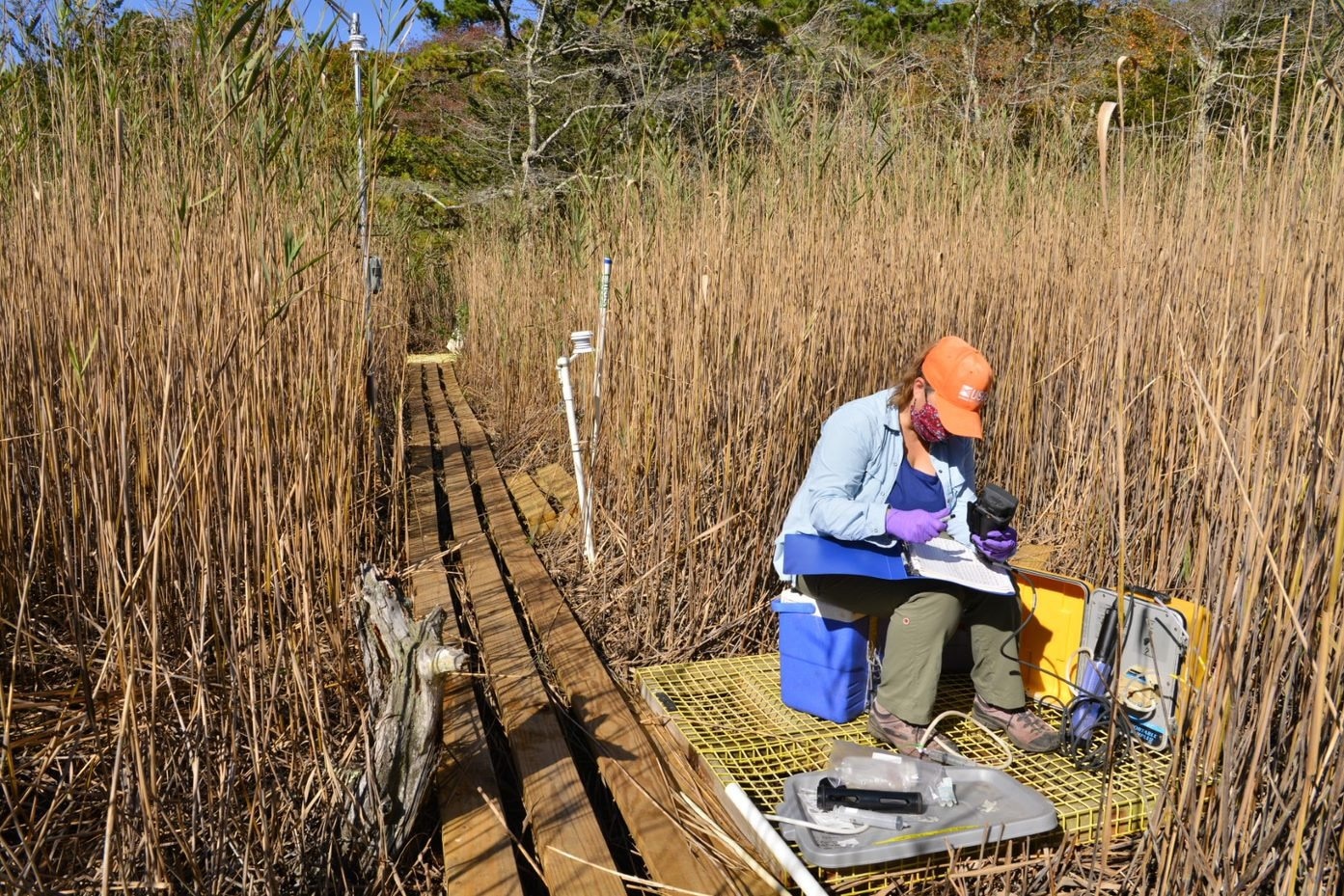Did you know that oceans capture a large amount of carbon dioxide from the atmosphere, helping mitigate climate change? It’s true, and scientists are investigating whether oceans can store even more of the greenhouse gas than they already do.
 USGS scientist Jennifer O'Keefe-Suttles samples water in a wetland in Mashpee, Massachusetts, to understand which environmental drivers impact carbon cycle and sediment accretion. Image Credit: Sandra Brosnahan, USGS.
USGS scientist Jennifer O'Keefe-Suttles samples water in a wetland in Mashpee, Massachusetts, to understand which environmental drivers impact carbon cycle and sediment accretion. Image Credit: Sandra Brosnahan, USGS.
Oceans cover approximately 70% of the Earth’s surface and can store carbon for a long amount of time. The exact period isn’t currently known though and could be hundreds to thousands of years or more.
The U.S. Geological Survey and partners are diving in to answer questions such as how carbon reaches oceans, how much carbon is already sequestered there, how much more could be captured and how long it can be contained. Plus, scientists are researching how certain minerals might augment the storage process. The type of carbon they are studying could also help neutralize ocean acidification.
“Several approaches are being considered and combined in an effort to reduce greenhouse gases to targeted levels in the next century, and part of that strategy is looking at the oceans,” said USGS research chemist Kevin Kroeger. “The USGS has been researching carbon capture on land and in oceans for several years, and we are embarking on two new projects to study the ocean in more detail and learn how certain processes may help sequester additional carbon that does not contribute to ocean acidity.”
Project One: From Wetlands to Oceans
There are many ways carbon can enter ocean water. One new effort led by the USGS is focusing on a non-acidic form of carbon washed from tidal wetlands into oceans. Tidal wetlands are areas where the land meets the sea.
Plants – in wetlands and other landscapes – absorb carbon dioxide from the atmosphere. A portion of that is stored in their roots and soil. In a wetland, some is then transferred to and stored in seawater and the remainder is released back out into the atmosphere as carbon dioxide again.
Neutralizing Ocean Acidification
USGS scientists are also studying how the movement of carbon in wetlands may help with ocean acidification. Increasing levels of carbon dioxide in the atmosphere have contributed to more acidity in the oceans, negatively impacting coral reefs, shellfish and other marine life. Not all types of carbon, however, are acidic.
Oceans can absorb carbon dioxide directly from the atmosphere, and that form of carbon is acidic. Some of the carbon transferred from wetlands to oceans, however, is in the form of bicarbonate, which can help counteract and neutralize acidity.
Project Two: The Magic of Minerals
The other new USGS-led project is looking at whether adding the mineral olivine to coastlines may bring additional carbon to ocean water and assist in mitigating acidification.
Olivine is known to naturally absorb carbon dioxide, and scientists are adding it to coasts in the form of light green sand. Studies will focus on how olivine changes the chemistry of sea water and if that allows it to capture and hold some of the carbon dioxide released from a wetland. Olivine transforms the carbon in seawater to bicarbonate too.
Informing Decisions
This USGS science can help federal, state and local government entities as well as private organizations understand how land management actions could affect the health of the nation’s oceans and coasts and their ability to hold carbon. Decisions could include coastal restoration and conservation, planning for infrastructure such as dams, dikes and roadways as well as protecting against sea level rise, coastal erosion and other concerns. This research can also help inform organizations considering technology and other methods to draw more carbon out of the atmosphere.
Measuring Gases
See-through cylinder chambers are used by USGS scientists to monitor the exchange of gases between ecosystems and the atmosphere. Scientists also use sensors to measure water flowing between wetlands and the ocean as well as the chemistry of that water. This can help give insight on the amount of carbon entering oceans from different types of wetlands, including those where scientists applied olivine.
In addition, the USGS and colleagues are collecting satellite imagery and analyzing it to identify wetland conditions across the country. Data from both of those efforts can be combined to estimate the movement of carbon in those settings at local, regional and national scales and the potential to store more carbon in oceans.
Start With Science
USGS scientists are involved in several projects regarding carbon storage along the coasts, looking beyond just the oceans. As an example, learn more about science to understand carbon storage in plants and soils as well as the release of methane and other gases from various types of wetlands. The process of storing and releasing carbon within coastal wetlands is called, “blue carbon.”
By starting with science, more insight can be gained on the role wetlands and oceans play in a comprehensive strategy to address climate change and human-caused carbon emissions.
Partnerships
The two new efforts are collaborative projects between the USGS with other federal government agencies, academic institutions and industry partners. Partners and collaborators on the olivine research include the National Oceanic and Atmospheric Association, the National Park Service’s Cape Cod National Seashore, the Woods Hole Oceanographic Institution and Vesta. On the wetland carbon transport project, partners and collaborators include the National Aeronautics and Space Administration, the WHOI, the University of Connecticut, the Smithsonian Environmental Research Center, California State University East Bay, the City College of New York and Silvestrum Climate Associates.